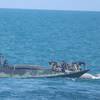By David Tinsley, technical editor
In a bold move to simplify and expedite the entire ship surveying process, Germanischer Lloyd (GL) has implemented a new, information technology (IT) tool for use by its stations around the world. Heralded as a revolutionary step forward in surveying, the customer-driven initiative is known as TRON, and is intended to replace complicated, time-consuming correspondence with a largely electronically-based surveying process linked to the GL intranet.
The value of TRON should be best realized when used in conjunction with 'fleet online', GL's Internet portal.
The powerful new instrument of service and operations enables the necessary survey information, such as status and timing, to be published on 'fleet online' within 24 hours, placing data at the client's disposal significantly earlier than was previously possible. The IT-based arrangements promise a more transparent and easier-to-follow survey process, as well as speedier execution at the requisite high standards.
Developments such as this cut both ways, offering an improved survey service contributing to the operational safety and efficient running of the ship, while potentially enhancing the society's own efficiency, routines and reliability. Moreover, while TRON looks set to greatly facilitate and safeguard customers' planning processes, it also means that each surveyor will shoulder a greater share of responsibility in keeping with more decentralized arrangements.
The various technical reports in use up to now have been brought together in a single survey statement that focuses on the demands of the vessel type involved. The surveyor on the spot works his way through a catalog tailored to the specific scope of the survey in question, and which takes all the relevant survey parameters into account. From this, the technical report is automatically drawn up. At the same time, there is no longer any distinction between classification and statutory reports.
Benefits conferred by TRON through linking with the GL intranet include the capability for quickly communicating the latest GL and IMO rules and other edicts to surveyors in every location, and the means it provides for each surveyor to have continual access via his or her PC to the society's knowledge and information resources at the Hamburg head office. "In this way, we can offer the best possible decentralized survey process," observes the society.
GL claims that it was the first classification society to offer customers the chance to plan surveys on-line and order a survey on a specific date via the Internet. Launched at the beginning of 1999. 'fleet online' has been providing a survey order service since February 2001. More than 1,000 companies controlling over 3,800 vessels are now registered to use this free service.
Wärtsilä: A Fountain of Ideas
A new concept for powering large passenger vessels, the combined diesel-electric and diesel-mechanical (CODED) system, is the latest outcome of a broader co-operation between leading lights in the Finnish maritime industries. CODED has been developed by Wärtsilä Corporation to address the needs of cruise ships of the future, and is an outcome of its joint endeavors with the technology arm of Kvaerner Masa-Yards to find new design and machinery solutions for the next generation of vessels. Formulated for a 25-knot breed of Panamax cruise ship of 90,000-gt, arranged to accommodate 2,500-passengers, the CODED propulsion configuration is of a hybrid nature, using two electric motor-installed pods and one mechanically-driven, feathering controllable pitch propeller. The CODED machinery layout is claimed to offer the benefits normally associated with a 'conventional' diesel-electric power and propulsion plant, but at a lower cost. Compared with an all diesel-electric, twin pod solution, the new concept is said to promise better hydrodynamic performance, equally good maneuvering and significantly improved economics, with a seven-percent reduced power need at the propellers. A key benefit attributed to the CODED system is the factor of flexibility, whereby installed prime mover capacity can be better matched to different needs in different situations. In addition, it permits the diesel engines to be run at constant speed and at more efficient loads, to the good of overall fuel consumption, while it affords the ship designer greater freedom in main engine location. At low and medium vessel speeds, the ship is propelled by the twin, steerable pods alone. At high speeds, the centerline, mechanically-driven propeller is also actuated. When not in use, the centerline propeller is feathered, whereby the pitch is changed to align the blades with the waterflow, allowing for significantly less resistance than that encountered with a windmilling propeller. For operations in the higher speed range, it is proposed that steering is achieved by way of a Lips High Efficiency Rudder fitted behind the centerline propeller, with the pods then locked into position. After investigating various CODED machinery options for the envisioned Panamax cruise ship, Wärtsilä settled on a layout using a total of five 9L46 diesels in the gensets for the diesel-electric side to the system, feeding power to the electrical pods, plus two 12V46 models to drive the centerline mechanical propeller. Total plant output would be approximately 72.5-MW.
Featured videos

Inmarsat Enhances Service to Drive Digitalization

Tracking Foreign Vessels Working in the U.S. Jones Act Market

Unlock Onboard Data Efficiencies
Subscribe for
Maritime Reporter E-News
Maritime Reporter E-News is the maritime industry's largest circulation and most authoritative ENews Service, delivered to your Email five times per week









